You have to consider a lot of things when choosing new plants for your garden, but one of the first things you should decide is your goal. In other words, you have to decide whether you want to grow edible vegetables for their culinary value, or do you want to grow pretty ornamentals that will make your garden look amazing.
In truth, you don’t always have to choose between a productive or ornamental garden because some vegetables provide not only tasty produce but incredible colour that’ll also beautify your garden!
Read on to find out why some vegetables are so colourful and we'll share some of our favourite examples that you may want to try for yourself.
Why Are Most Vegetables Green?
To understand why some vegetables are so colourful, you have to first understand why most plant parts aren’t. As you probably know, wild plants are typically green, save for structures like fruit and flowers.
This isn’t arbitrary either; most plants are green because they contain chlorophyll – a green-coloured pigment that is responsible for photosynthesis. The more portions of a plant that contain chlorophyll, the more effectively the plant can produce food to fuel its growth and other biological processes.
Plant parts that aren’t normally green usually serve another purpose for the plant, which may be more important to the overall organism than producing sugar. For example, fruit have often evolved to be attractive to animals, who’ll then eat them and disperse the seeds they contain. Meanwhile, flashy flowers use their bright colours to attract bees, birds, butterflies, and other pollinators.
What Causes Some Vegetables to Be Colourful?
It’s important to note that chlorophyll isn’t the only kind of pigment plants produce. Some plants also produce one or more of the following pigment types:
- Carotenoids (red, orange, or yellow)
- Anthocyanins (pink, purple, red, and blue)
- Betalains (red and yellow)
- Xanthophylls (yellow)
- Flavonoids (white, yellow, blue, and red)
These pigments are generally limited to the colourful plant structures such as flowers and fruit. But occasionally, plants develop genetic mutations that cause them to produce these pigments in other structures, such as the leaves or stems.
Usually, these differently coloured plant parts still contain chlorophyll, so they continue to photosynthesize and produce food. They just don’t appear green because the other pigments mask the green colour such as in Japanese maples (Acer palmatum), which bear red or burgundy leaves.
In the wild, these colourful “mutants” usually don’t amount to much, but when horticulturists and gardeners get their hands on these colourful plants, they can begin deliberately cultivating them and eventually, these colourful plants end up being available to gardeners like you.
Which Parts of Vegetables Are Colourful?
A number of plant parts can be colourful, including:
- Stems: Some varieties of silverbeet may have very brightly coloured stems, ranging from white to red, yellow and orange.
- Roots: Carrots are obviously available in a rainbow of colours, but turmeric, beets, and turnips are also colourful.
- Fruit: Many plants produce brightly coloured fruit, but peppers, chillies, tomatoes, and pumpkins are some of the best examples.
- Leaves: Various lettuce and kale cultivars produce leaves ranging from red to purple, and they sometimes have curly leaves, which provide additional aesthetic value.
- Flowers: It may not be obvious but the parts of brassicas we eat (broccoli and cauliflower) are in fact large flowerheads, and some of these produce colourful flower buds such as in the purple or lime green cauliflowers.
Grow Colourful Vegetables for Your Garden and Kitchen
Colourful vegetables can certainly make your garden more beautiful, but they’re also great for colouring up your culinary creations – we’re all supposed to eat colourful vegetables for the health benefits they provide, anyway. Growing and using colourful vegetables could also be used to encourage fussy eaters to try new things, if nothing else, for the novelty of eating unusual coloured vegetables.
Professional chefs often use brightly coloured fruits and vegetables to enhance the visual appeal of the dishes they prepare, so why not try doing so yourself? Sometimes the ingredients they use to add colour are hard to find in grocery stores, but by growing your own colourful produce, you’ll never have a problem creating your own masterpieces!
Many fruits and vegetables “hide” their most beautiful colours on the inside. This means they don’t really add any colour to your garden, but if you cut or slice them in clever ways, you can add an incredible splash of colour to your meals.
Note that some of these vegetable parts lose their bright colours when cooked (e.g., purple asparagus and purple beans). Some may find this disappointing, but others may be relieved that the fruits and vegetables they cook won't look like something out of a cartoon.
Colourful Vegetables to Grow in Your Garden
We’ve rounded up some of the most colourful and festive vegetables that you may want to include in your garden, and to make it easy, we’ve grouped these based on the colour they will provide your garden.
Vegetables with Red Parts
- Amaranth ‘Red Garnet’ is a tall plant with tasty, but also highly ornamental bright-red leaves.
- Lettuce ‘Selway Red’ has glorious red leaves (sometimes appearing slightly purple) and the colour intensity increases when these plants are exposed to heat or frost; Other red-leaved lettuce cultivars include ‘Lollo Rosso’ and ‘Red Cos’.
- Carrot ‘Atomic Red’: Carrots come in a variety of colours, but few are as eye-catching as ‘Atomic Red’. Note that the highly colourful carrots taste best and look most colourful after they’re cooked.
- Watermelon ‘Warpaint’, while merely green and white on the outside, has vibrant red flesh that contrasts strikingly with the fruit’s black seeds.
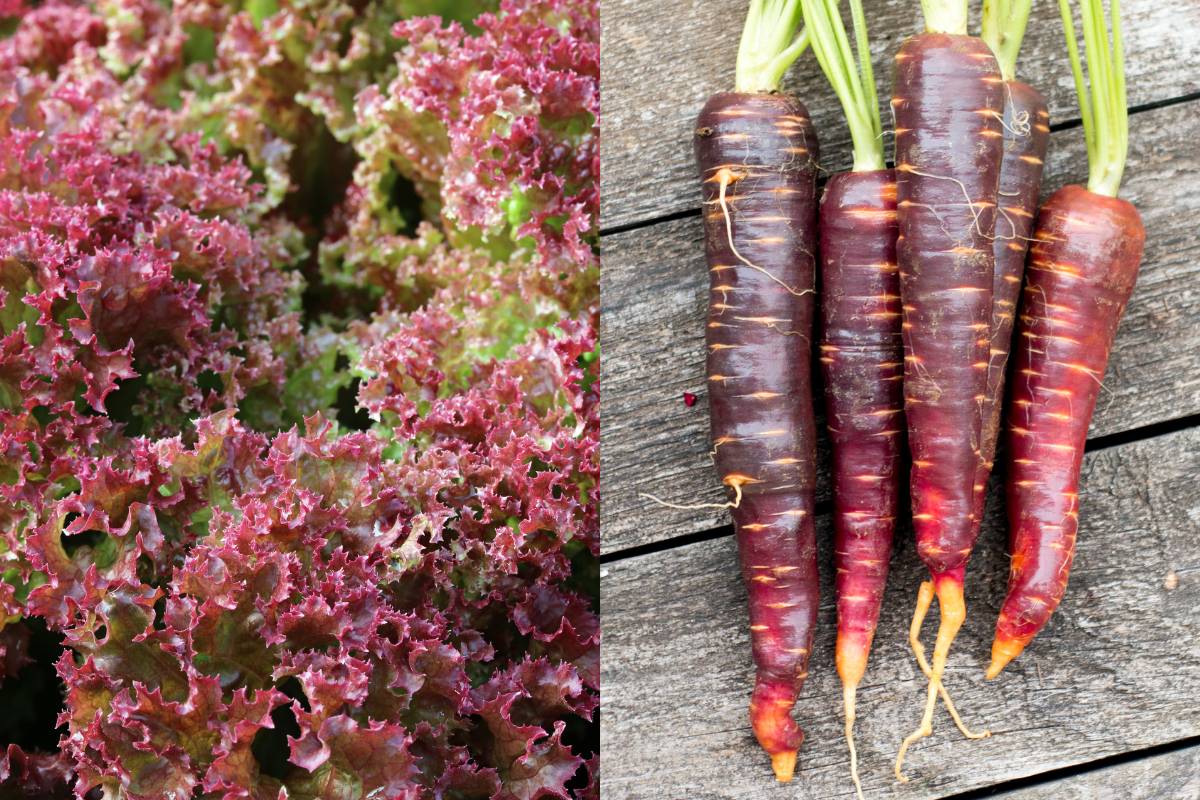 Red leaves of lettuce and red carrot roots
Red leaves of lettuce and red carrot roots
Vegetables with Pink Parts
- Beetroot ‘Chioggia’ has very attractive alternating pink and white and white rings, although you won’t see them until you harvest and cut them.
- ‘Ruby Lou’ Potatoes not only have delightful pink skin, but are easy to peel and can be cooked just about any way you like.
- Chinese Celery ‘Pink’ is an easy-to-grow pink-stemmed biennial, that will produce the deepest colour when exposed to cold temperatures and bright sunlight. As a bonus, the leaves of these plants can be used as a flavouring agent.
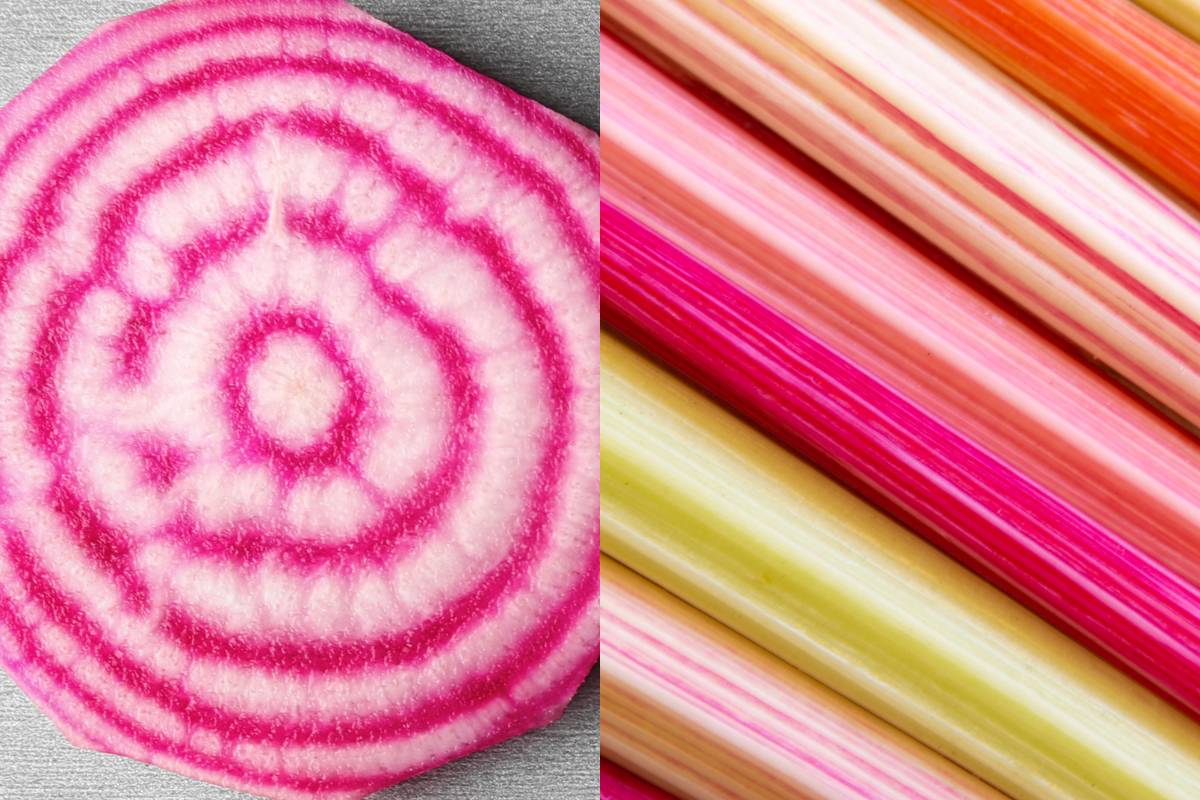 Pink-striped 'Chioggia' beetroot and pink chard stems
Pink-striped 'Chioggia' beetroot and pink chard stems
Vegetables with Orange Parts
- Silverbeet ‘Orange Fantasia’ is a productive silverbeet variety with light orange stems and slightly curly leaves, which are perfect for harvesting when young.
- Carrot ‘Mercado De Paris’ is a small round, cheerful bright orange carrot that offers not only bright colour but interest on the dinner plate.
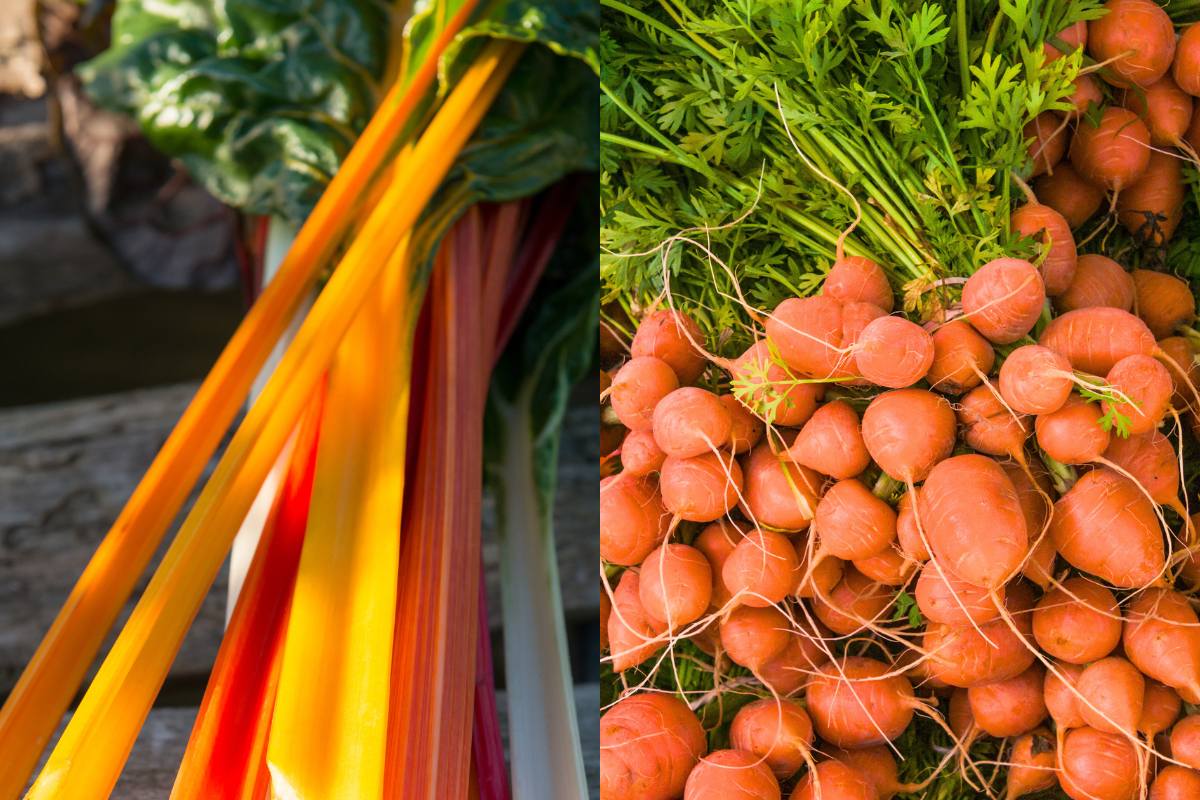 Orange chard stems and round orange carrots
Orange chard stems and round orange carrots
Vegetables with Yellow Parts
- Silverbeet ‘Golden Sunrise’ is highly productive and has golden yellow stems.
- Carrot ‘Solar Yellow’ lives up to its sunny name being an entirely yellow carrot that is also sweet and super-crunchy.
- Chilli ‘Rocoto Manzano Yellow’ is one of the best chillies for cool climates. This tall and long-lived plant produces yellow-skinned chillies that eventually turn orange when they mature. The black seeds can be removed when preparing them, if you need to reduce the heat a bit.
- Watermelon ‘Mountain Sweet Yellow’ has unusual bright yellow flesh. Renowned for their sweet taste, the fruits of this cultivar are elongated and can weigh 10 kg or more.
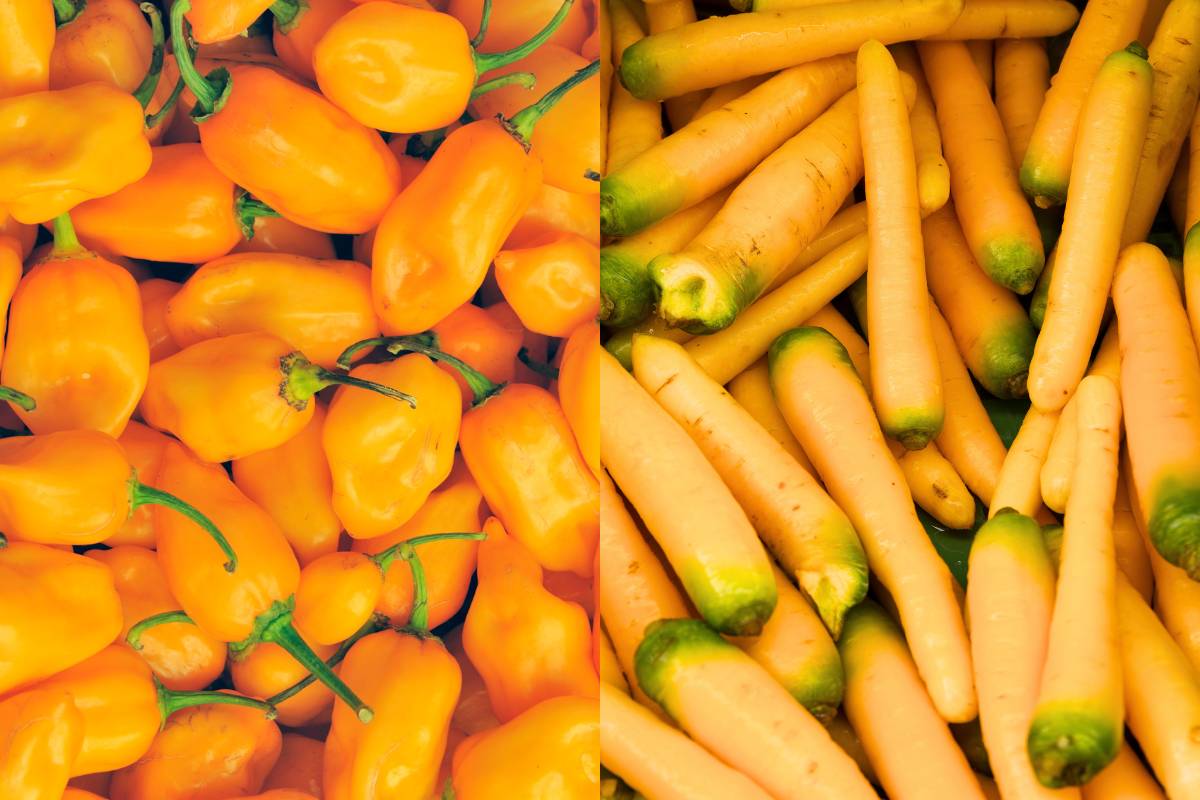 Yellow Habanero chillies and yellow carrots
Yellow Habanero chillies and yellow carrots
Vegetables with Purple Parts
- Artichoke ‘Colorado Red Star’ along with other artichoke varieties such as ‘Purple Headed’ and ‘Romanesco’ produce attractive purple-tinged buds.
- Purple Asparagus not only does it add a bit of colour to your garden, but its spear-like shape provides another form of visual interest in the garden. Just note that these stalks will turn green when cooked.
- Kale ‘Scarlet’ produces some of the most vivid purple leaves of any garden plant, despite its “scarlet” moniker.
- Carrot ‘Cosmic Purple’ is one of the most eye-catching vegetables around. Not only do they have deep purple roots, but they also have purple-tinged stems at times, providing some above-ground beauty too.
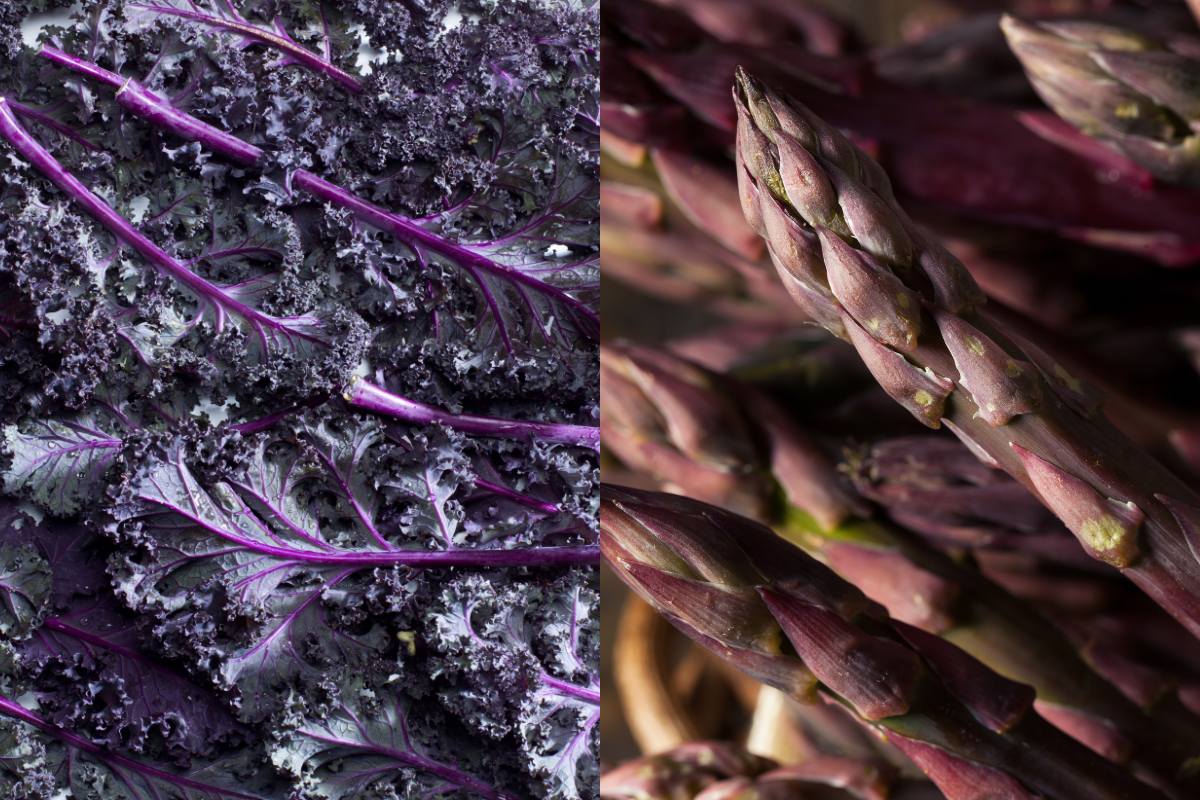 Purple kale and purple asparagus
Purple kale and purple asparagus
Vegetables with Blue Parts
- Corn ‘Blue Hopi’ must not have gotten the memo, because blue is a relatively rare colour in nature. It's a drought-tolerant cultivar and the ears are best eaten when young.
- Watermelon ‘Black Diamond’ won't be considered “blue” by everyone; some think they look green, while others consider them black, but some gardeners do feel that they look bluish in the right light.
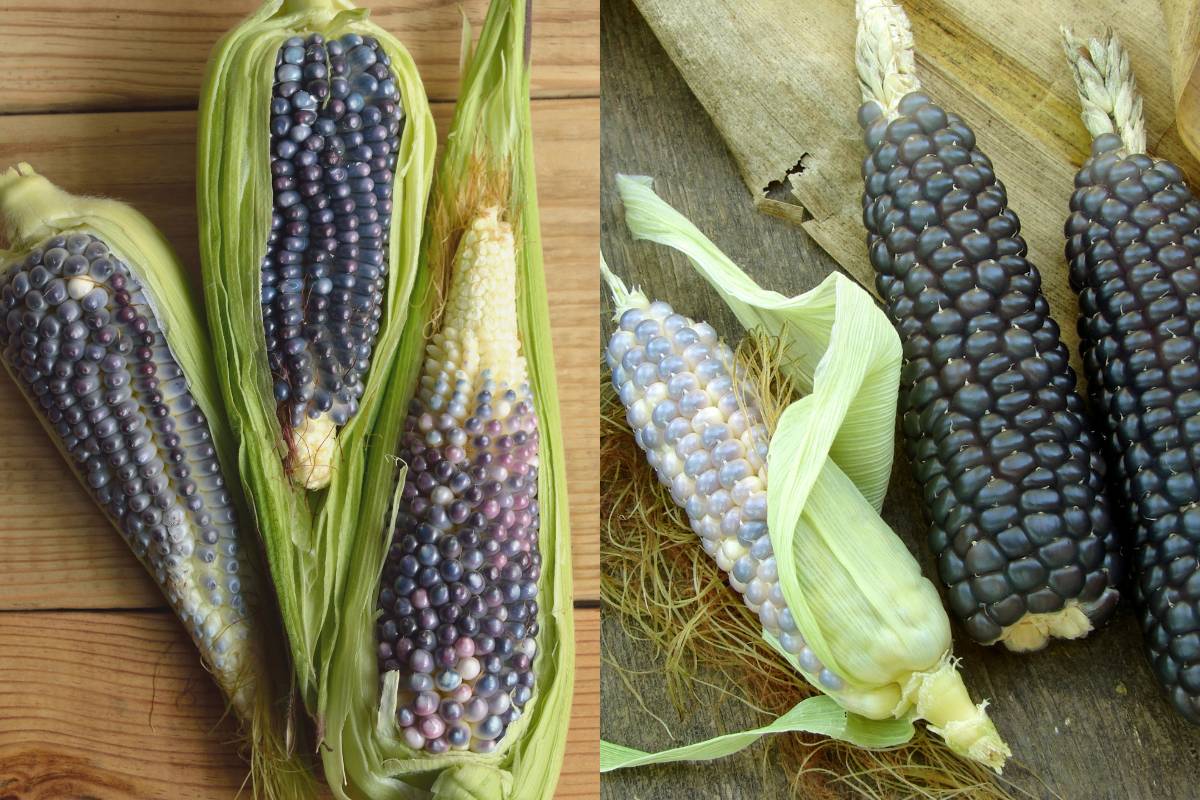 Mini blue corn cobs
Mini blue corn cobs
Vegetables with White Parts
- Parsnip ‘Melbourne White Skin’ has long white roots like other parsnips. When growing parsnips, to achieve the best flavour, leave them in the ground until after a frost as this will help the sugars to develop more.
- 'Peruvian White' Chilli, sometimes called ‘Jelly Bean Chillies' are a great option for introducing some 'white-hot' heat into your garden. The plant stays relatively small, making it suitable for containers.
- ‘Crown of Thorns’ Gourd is an unusual crown-like ornamental gourd that can range in colour, but they’re often creamy white with green stripes.
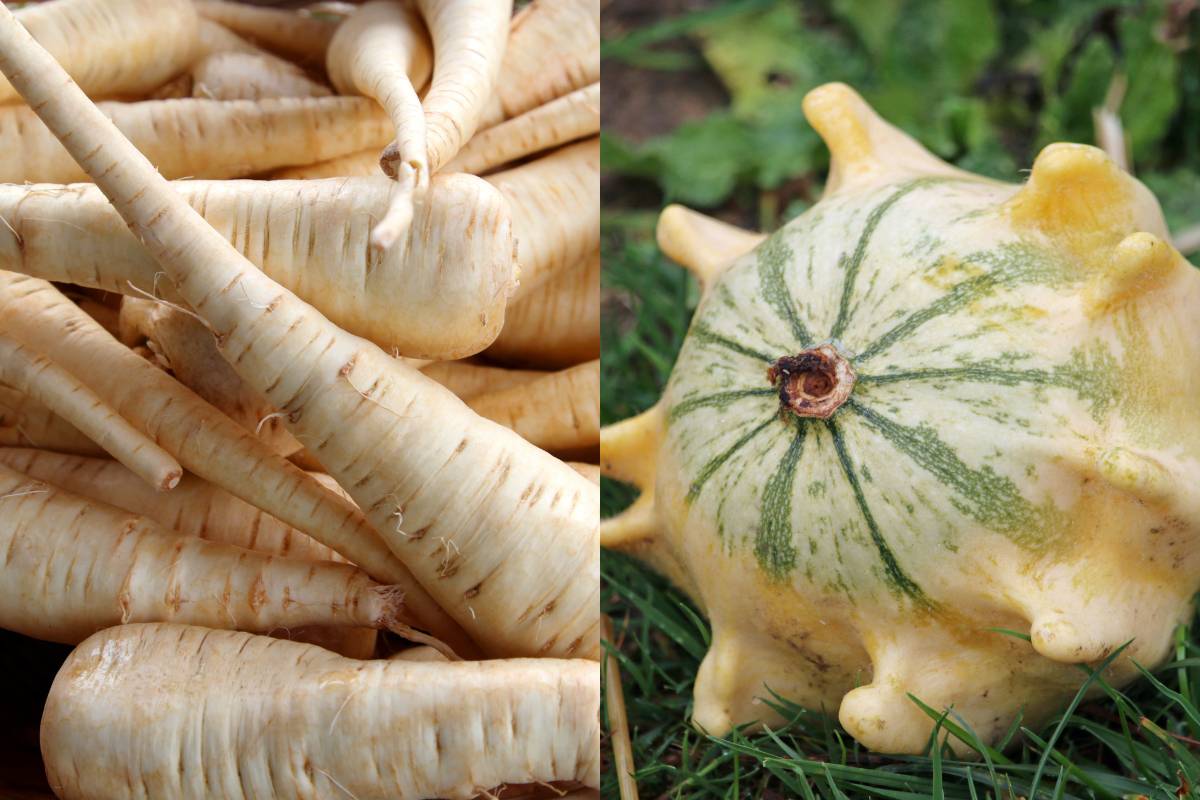 White parsnip roots and creamy-white Crown of Thorns gourd
White parsnip roots and creamy-white Crown of Thorns gourd
Vegetables with Black Parts
- Black Salsify’ is an underappreciated black-skinned root vegetable with a taste likened to asparagus. Notably, the interior flesh of the root is white, giving it a unique appearance when served.
- Chilli ‘Hungarian Black’ is considered dark purple rather than black, but they’re so dark that we’re putting them with the black vegetables. The fruit do eventually turn red as they mature, but they remain very dark for some time. These plants also produce purple-veined leaves, providing additional decorative value.
- ‘Mitoyo’ Eggplant is a Japanese variety of eggplant with very dark purple to almost black skin. The fruits can be teardrop, oval, or round in shape.
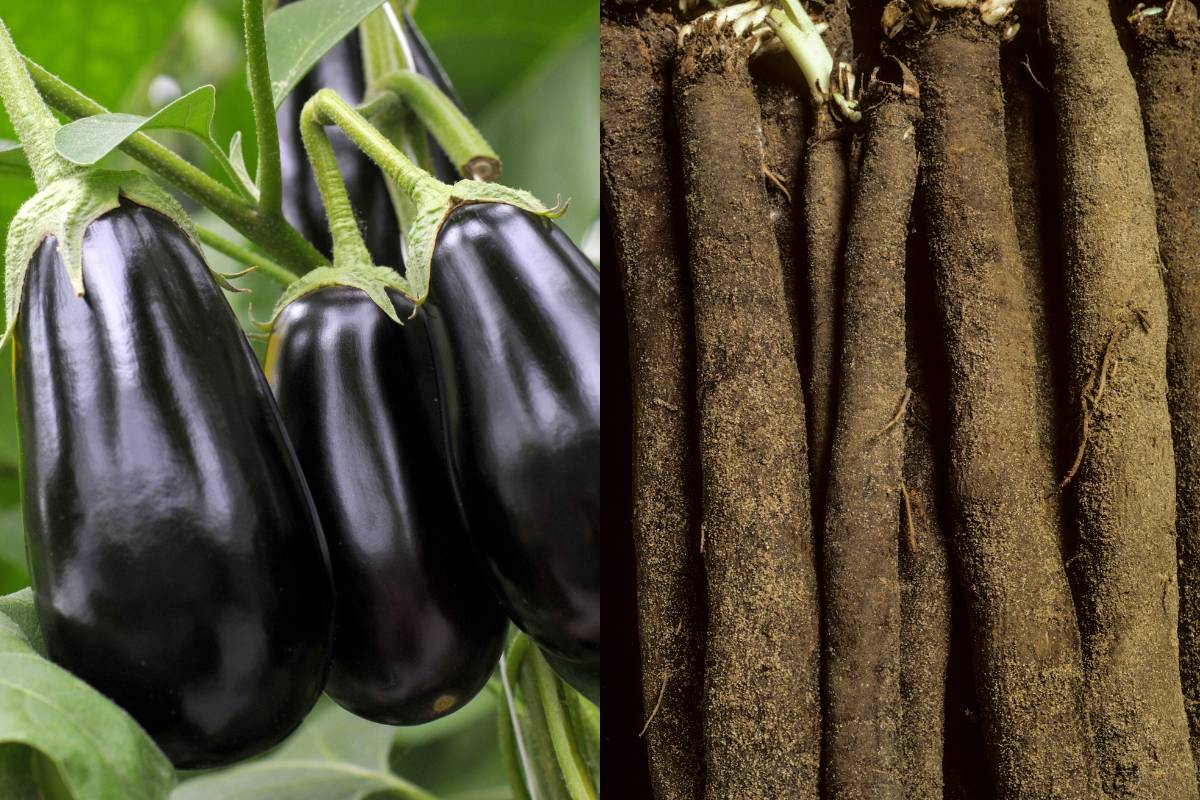 Dark purple-black eggplant and black salsify
Dark purple-black eggplant and black salsify
“Rainbow” Vegetables
- Rainbow Chard (‘Bright Lights Mix’) is a silverbeet mix with stems that provide a “rainbow” of stem colours, including red, pink, yellow, orange and white.
- Carrot Rainbow Mix is also a mix of different coloured carrots, and while you won’t see much above-ground colour when growing these seeds, the harvest will be fun as you pull up a variety of red, orange, white, yellow, and purple roots.
- Corn ‘Glass Gem’ is perhaps the most colourful vegetable you can grow. These kaleidoscopic ears of corn bear a rainbow of semi-transparent kernels and are best when popped or ground into flour.
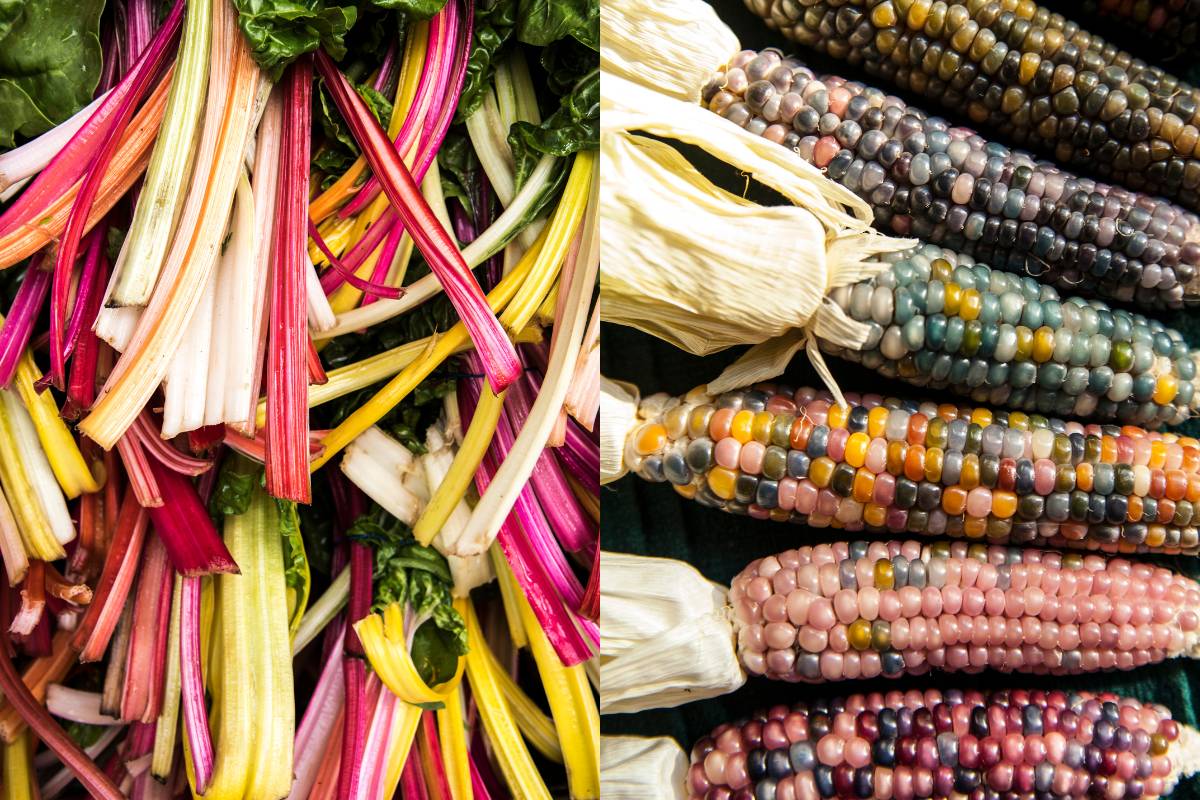 Rainbow coloured stems of Swiss chard and translucent Corn 'Glass Gem' kernels
Rainbow coloured stems of Swiss chard and translucent Corn 'Glass Gem' kernels
Making the Most of Vegetable Colour
In addition to choosing colourful vegetables for your garden, there are a few other things you can do to help capture a rainbow in your garden (and kitchen). None of the following suggestions will turn drab green plants firecracker red, but they will often help bring out the best your plants have to offer.
Cold Temperature Exposure
A number of vegetables develop better colour when exposed to low temperatures. It’s even wise to leave some in the ground until after the first couple of frosts. This not only includes ‘Pink’ Chinese celery, ‘Selway Red’ lettuce, ‘Melbourne White Skin’ parsnips, and other varieties as mentioned earlier, but it also includes many carrots and beets.
Bright Sunlight Exposure
Bright, sunny days can also help bring out the best colour in some vegetables. You obviously can’t change the weather, but you can try to maximise this effect by planting vegetables that have coloured stems in places that receive the best possible sun exposure – that way, the plants can take advantage of sunny days when they occur.
Proper Storage
After harvesting your vegetables, be sure to store them properly. This won’t necessarily improve their colour, but it can help prevent them from browning or yellowing as quickly which they may do if stored improperly. Different fruits and vegetables are best stored in different ways, but when in doubt, keep them in a dark, cool, and dry place. Some vegetables produce enzymes that may become activated when the temperatures are too high, which can accelerate the browning associated with bruises. Similarly, high humidity levels can support microbial activity, which will compromise the beauty of some fruits and vegetables.
Blanching
Blanching is a cooking technique that helps to lock in the flavour and colour of vegetables. You can even freeze them after blanching without compromising their texture. Best of all, blanching is a very simple process. Simply boil the vegetables for about one to five minutes; when you see the vegetables’ colour start to intensify, take them out and plunge them into a container of ice water to stop the cooking process. You can then eat, sauté, roast, or freeze them as desired.
***
As you can see, there are tons of vegetables that are not just green which can add a splash of colour and interest to your garden. As always, be sure to consider your local climate and soil characteristics before selecting the specific seeds you want to buy.
We’d offer one more bit of advice: Make sure you look at examples of different varieties – don’t just consider the cultivar name. Some vegetables, such as ‘Black Beauty’ zucchini, have somewhat misleading names, because despite their black moniker, these zucchinis are actually just very dark green in colour. Similarly, ‘Red Express’ cabbage is purple, despite having the word “red” in its name.





